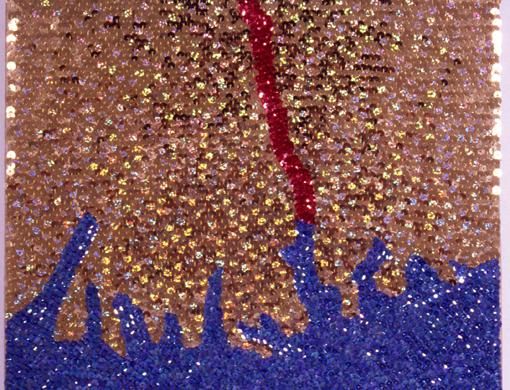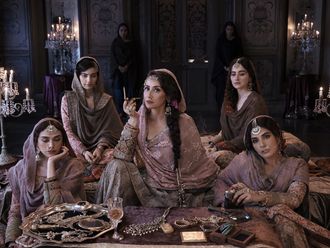The past two years marked the 60th anniversary of two groups of nations that were created through partitions: India and Pakistan (which was itself partitioned 24 years later to form Bangladesh) and Palestine and Israel (formed by the partition of British-controlled Palestine).
Both partitions have had an unprecedented impact. The fracture of India led to more than 15 million people being displaced and an estimated one million deaths.
The formation of Israel remains a leading cause of global geopolitical instability.
Lines of Control, an exhibition of works by 18 artists and an art collective from the Middle East and South Asia, explores the chaos and the productive capacity of the partitions through a range of communicative media.
The artists whose works are on display are: Bani Abidi, Roohi Ahmad, Farida Batool, Rana Begum, Iftikhar Dadi and Nalini Malini, Anita Dube, Sophie Ernst, Ahsan Jamal, Amar Kanwar, Tariq Khalil, Ahmad Ali Manganhar, Naeem Mohaiemen, Rashid Rana, Seher Shah, Abdullah Syed, Hajra Waheed, Mohammad Zeeshan and the Raqs Media Collective.
The works portray the devastated lives in South Ossetia, Baghdad's Green Zone and Red Zone, Israel's “security barrier'', Kosovo, the Kurdish areas in Iraq and Turkey, Pakistan's tribal areas and in India's minority provinces.
Anita Dube's sculptural drawings are created from mass-produced ceramic eyes used for the consecration of Hindu deities in temples.
In River Disease, she has arranged these ceramic eyes in the shape of the five rivers running through the province of Punjab that borders India and Pakistan, recalling the rivers of blood that flowed in the wake of the territory's painful division.
The religious origin of Dube's material and tension over territorial water rights add contemporary frisson to the historical context.
An architect by training with a bachelor's degree in fine arts from the Rhode Island School of Design, Seher Shah layers multiple historical and geographical references with personal imagery and drawings stemming from architecture and symbolic geometries.
“Having lived in London, Brussels and New York for most of my life and [having travelled] to Pakistan and India, my childhood memories are fluid in terms of geographies and styles. Therefore they are natural layering elements [in my works],'' Shah says.
For Lines of Control, she has produced a large-scale work titled Monumental Fantasies: Impermanence I.
“Monumental Fantasies focuses on the role of monuments as colonial markers and a means to enforce the idea of spectacle. There is no set method for my work.
"Each work, or series, develops in its own unique way. There is, however, a lot of research and points of intersection in the works.
"Monumental Fantasies has its roots in archival documentary photography from various sources, travel photography, ornamental art, animation and urban graffiti, as well as architectural drawings,'' Shah adds.
Iftikhar Dadi, whose works are often produced collaboratively with partner Elizabeth Dadi, and Nalini Malini, the internationally acclaimed artist, have reworked Bloodlines — their piece from the Mappings exhibition by New Delhi's Eicher Gallery in 1997 — for Lines of Control.
The textile panels of Bloodlines map the Radcliffe Line which defined the India-Pakistan border in 1947, using gold, crimson and royal blue sequins.
The rectangular panels mimic the mapping process, which defines borders with detached scientific objectivity.
“Bloodlines was created as a meditation on the partition of India and Pakistan in 1947, which led to the uprooting and migration of millions and much bloodshed,'' Iftikhar says.
“It continues to haunt South Asia and by continued tension, violence and militarism prevents the region from developing its human potential.
"The cost of this confrontation has been staggering and has led to an impoverishment of the human possibilities that South Asia has historically been endowed with in plenitude.''
According to Malini, the work attempts to gesture towards what has been lost, yet also offers a vision of the future.
Naeem Mohaiemen uses video, photography, archives and text to explore failed revolutions and the slippage from Utopia to dystopia. At Lines of Control, Mohaiemen explores poet Kazi Nazrul Islam through Kazi in No Man's Land.
“My projects are spurred by conversations [with] friends where ephemera from history pop up. I am particularly interested in exploring the micro-narratives within historic moments.
"From the context of Bangladesh, history continues to be the prism through which we see the present and future. … I explore history to understand the present and as a form of political activism.
"I wanted to look at the period when Kazi Nazrul Islam lost his speech.''
The works of Rashid Rana explore Pakistan's many attempts to define a national identity. He uses the conceptually simple but powerful device of marshalling thousands of small photographs to create a large-scale digital image.
In All Eyes Skywards at the Annual Parade, Rana shows a Pakistani crowd admiring the choreographed fly-pasts of fighter aircraft at an annual display of national fervour.
The crowd looks upwards, many in it clutching Pakistan's flag. The seemingly banal image on closer inspection transforms into a mosaic of stills from Bollywood films.
“This work brings to the forefront the irony behind building identity out of national borders and shows the fluidity and contradiction within trying to identify, extricate and clearly define cultural categorisations,'' Rana says.
“By showing the image of a celebration of our nationality, which is created by underlying images of Bollywood stars, I wanted to show the irony in two cultures that on the surface are growing further apart, yet inside are inextricably intertwined.
"I tried to create a composite reality, which challenges the traditional lines imposed upon the definition of culture.''
Layla Haroon is a freelance writer based in Abu Dhabi.
Lines of Control runs at the Third Line Gallery, Dubai, until February 8.
Form and colour of divided destinies
Form and colour of divided destinies













